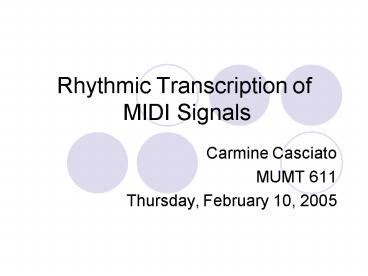Rhythmic Transcription of MIDI Signals - PowerPoint PPT Presentation
Title:
Rhythmic Transcription of MIDI Signals
Description:
Unidirectional message stream at 3.125KHz. System Real Time ... velocities, pitches. However, no knowledge of acoustic properties of sound. 4 /16 ... – PowerPoint PPT presentation
Number of Views:65
Avg rating:3.0/5.0
Title: Rhythmic Transcription of MIDI Signals
1
Rhythmic Transcription of MIDI Signals
- Carmine Casciato
- MUMT 611
- Thursday, February 10, 2005
2
Uses of Rhythmic Transcription
- Automatic scoring
- Improvisation
- Score following
- Triggering of audio/visual components
- Performance
- Audio classification and retrieval
- Genre classification
- Ethnomusicology considerations
- Sample database management
3
MIDI Signals
- Unidirectional message stream at 3.125KHz
- System Real Time Messages provide Timing Tick
message - A simplification of acoustic signals
- No noise, masking effects
- Easily retrieve note onsets, offsets, velocities,
pitches - However, no knowledge of acoustic properties of
sound
4
Difficulties in Rhythmic Transcription
- Expressive performance vs mechanical performance
- Inexact performance of notes
- Syncopations
- Silences
- Grace notes
- Robustness of beat tracker
- Can the tracker recover from incorrect beat
induction? - Real time implementation
- (Dixon 2001)
5
Human Limits of Rhythmic Perception
- Two note onsets are deemed synchronous when
played within 40ms of each other, 70 ms for gt two
notes - Piano and orchestral performances exhibit note
onset asynchronicity of 30-50ms - Note onset differences of 50ms to 2s give
rhythmic information - (Dixon 2001)
6
Evaluation Criteria for Beat Trackers
- Informally - click track of reported beats added
to signal - Visually marking the reporting beats
- Comparing reported vs known, correct beats
- (Dixon 2001)
7
Definitions
- Beat - perceived pulses which are approximately
equally spaced and define the rate at which notes
in a piece are played - meterical, score , performance level
- tempo - beats per minute
- Inter-onset Intervals (IOI) - time intervals
between note onsets - (Dixon 2001)
8
Approaches - Probabilistic Frameworks
- Cemgil et al (2000) - Bayesian framework, using a
tempogram (wavelet) and a 10th order Kalman
Filter to estimate tempo, which is a hidden state
variable - Takeda et al (2002) - Hidden Markov models for
fluctuating note lengths and note sequences,
estimating both rhythms and tempo - Raphael (2002) - tempo and rhythm
9
Approaches - Oscillators
- Period and phase that adjusts itself to
synchronize to IOI input - Dannenberg and Allen (1990) - weighted IOIs and
credibility evaluation based on past input - Meudic (2002) - real time implementation of Dixon
- Induce several beats and attempt to propagate
them through the signal (agents), then choose the
best - Pardo (2004) - Oscillator, compared to Cemgil
using same corpus
10
Pardo 2004 - Oscillatory Design
- Is a Kalman Filter (Cemgil) or oscillator better
for online tempo tracking? - Performance as time series of weights, W, over T
time steps - Weight of time step with no note onsets 0,
increased proportional to of note onsets - 100ms is minimum IOI allowed, minimum beat period
11
Pardo 2004
- Uses weighted average of last 20 beat periods,
with one parameter varying degrees of smoothing - A correction parameter varies how far the period
and phase of the next predicted beat is changed
according to known information - A window size parameter affects how many periods
may affect the current prediction - Chose 5000 random values of these three
parameters, ran each triplet on 99 performances
of Cemgil corpora
12
Cemgil MIDI/Piano Corpora
- Four pro jazz, four pro classical, three amateur
piano players - Yesterday and Michelle, fast, slow and normal,
captured on a Yamaha Diskclavier - Available at www.nici.kun.nl/mmm/
13
Pardo 2004 - Error Measurement
(Pardo 2004)
- After finding best parameters values for
Michelle corpus, - applied same values to analysis of Yesterday
corpus - Compared to Cemgil using that papers defined
error - metric, which takes into account both phase and
period - errors, to come up with a score
14
Comparison of Approaches
(Pardo 2004)
- Oscillator somewhat better than tempogram alone,
- Somewhat worse than tempogram plus Kalman,
- yet fall within standard deviation (bracketed
numbers) - of Kalman scores
15
Other Considerations
- Stylistic information
- Training of tracker
- Musical importance of note
- Duration
- Pitch
- Velocity
16
Bibliography
- Allen, P., and R. Dannenberg. 1990. Tracking
musical beats in real time. In Proceedings of
the International Computer Music Conference 1990
1403. - Dixon, S. 2001. Automatic extraction of tempo and
beat from expressive performances. Journal of
New Music Research 30 (1) 3958. - Meudic, B. 2002. A causal algorithm for
beat-tracking. In Proceedings of Conference on
Understanding and Creating Music. - Pardo, B. 2004. Tempo tracking with a single
oscillator. In Proceedings of the International
Conference on Music Information Retrieval 2004. - Raphael, C. 2002. A hybrid graphical model for
rhythmic parsing. Artificial Intelligence 137
21738. - Takeda, H., T. Nishimoto, and S. Sagayama. 2002.
Automatic rhythm transcription from multiphonic
MIDI signals. In Proceedings of the International
Conference on Music Information Retrieval 2003.

